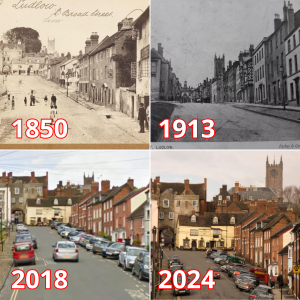
Introduction
Lower Broad Street in Ludlow, a town steeped in history and charm, offers a fascinating glimpse into England’s architectural and cultural evolution. With its rich medieval heritage, Ludlow’s streets tell stories of centuries past. This article provides a beautiful then-and-now comparison of Lower Broad Street, highlighting its transformation while celebrating its enduring allure.
Historical Background
Ludlow, located in Shropshire, England, boasts a history that dates back to the Norman Conquest. The town’s strategic location and its impressive castle made it an important administrative and military center. Lower Broad Street, one of Ludlow’s oldest thoroughfares, has witnessed significant changes over the centuries, evolving from a bustling medieval street to a picturesque modern-day destination.
Lower Broad Street Then
Historical photographs and illustrations of Lower Broad Street reveal a vibrant scene from medieval times through the early 20th century. The street was lined with timber-framed buildings, showcasing the architectural styles of the Tudor and Elizabethan eras. Cobblestone pathways and horse-drawn carriages were common sights, adding to the street’s old-world charm. The street served as a hub for trade and commerce, with bustling markets and shops catering to the needs of the local community.
Lower Broad Street Now
Today, Lower Broad Street retains much of its historical character while embracing modern amenities. Many of the original timber-framed buildings have been meticulously preserved, maintaining the street’s historical integrity. Modern shops, cafes, and boutiques now occupy these historic structures, blending the old with the new. The street’s cobblestones have been replaced with more practical paving, but the overall ambiance remains one of timeless beauty.
Architectural Significance
The architectural significance of Lower Broad Street lies in its well-preserved buildings that reflect the town’s medieval heritage. The timber-framed houses, with their distinctive black-and-white facades, are quintessential examples of Tudor architecture. These buildings, some dating back to the 15th and 16th centuries, offer a window into the past, showcasing the craftsmanship and design principles of their time.
Cultural Impact
Lower Broad Street’s cultural impact extends beyond its architectural beauty. The street is a living testament to Ludlow’s rich history and vibrant community life. It has been a focal point for various cultural events and festivals, attracting visitors from near and far. The street’s historical charm and modern conveniences make it a popular destination for tourists, contributing to Ludlow’s reputation as a cultural and historical gem.
Preservation and Legacy
Efforts to preserve Lower Broad Street have ensured that its historical significance is recognized and maintained. Local authorities and heritage organizations have worked together to protect the architectural integrity of the street, implementing conservation measures and promoting awareness of its historical value. These efforts have preserved the street’s legacy, allowing future generations to appreciate its beauty and historical importance.
Conclusion
Lower Broad Street in Ludlow offers a captivating journey through time, showcasing the town’s rich medieval heritage and its evolution into the modern era. The beautiful then-and-now comparison highlights the street’s transformation while celebrating its enduring charm. From its timber-framed buildings to its vibrant community life, Lower Broad Street remains a testament to Ludlow’s historical significance and cultural richness. Visitors to this historic town can experience the unique blend of past and present, making Lower Broad Street a true treasure of England’s architectural and cultural landscape.





